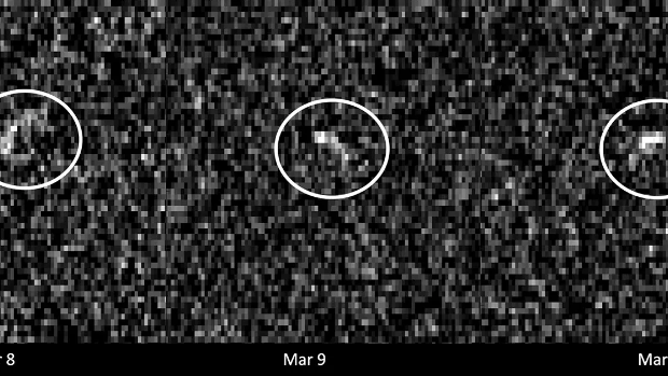Asteroid breaks up over Philippines hours after detection serving as reminder of bigger threats to Earth
Asteroid impacts on Earth happen all the time without prior detection, but telescope technology has improved, leading to more notice of these hurdling space rocks. According to NASA, 2024 RWI was only the ninth new asteroid detected prior to impact.
Watch: Video shows asteroid blasting across night sky above Philippines
A video shared from the Philippines shows a bright asteroid burning through the atmosphere on Sept. 5, 2024.
Hours after an Arizona observatory spotted a tiny unknown asteroid zooming toward Earth, it harmlessly crashed into our planet’s atmosphere, breaking up over the Philippines. While this 3-foot-wide asteroid wasn’t a threat, other asteroids have been discovered that have left Earthlings shaking in their boots for much longer.
The estimated 3-foot-wide asteroid named 2024 RW1 was first observed by the Catalina Sky Survey at the University of Arizona in Tucson about 8 hours before it hit Earth’s atmosphere. Astronomers believe the meteoroid was responsible for the fireball seen in the sky on Wednesday over parts of the Philippines.
Asteroid impacts on Earth happen constantly without prior detection, but telescope technology has improved, leading to more notice of these hurdling space rocks. According to NASA, 2024 RWI was only the ninth new asteroid detected before impact.
EARTH’S QUASI-MOON ASTEROID KAMO'OALEWA LIKELY BLASTED OUT OF THIS GIANT MOON CRATER
Telescopes around the world are constantly scanning the night sky for new discoveries, and in the name of planetary defense.
According to the Catalina Sky Survey, there are millions of asteroids within the solar system, with more than 615,000 identified and about 500,000 that need further observations to be classified.
But not all asteroids larger than 1 kilometer across have been found because not all space rocks are so easily detectable by telescopes, perhaps leaving some potential future threats still hidden.
Orbital dynamics researcher Renu Malhotra, a regent professor of planetary science at the University of Arizona, previously told FOX Weather it comes down to timing.
Near-Earth Asteroid Kamo'oalewa has been orbiting Earth for about 500 years but was only discovered in 2016.
"This one spins because it's kind of orbiting the Earth. Half of its orbit is in the sunlight. And so you look for asteroids pointing away from the sun during the nighttime … so it's only available to be detected about half its orbit period," Malhotra said.
How are asteroid threats to Earth defined?
NASA’s Center for Near Earth Object Studies identifies and characterizes the orbits of non-near-Earth objects, predicting their closest approach in coordination with NASA’s Planetary Defense Coordination Office. These offices use the internationally recognized Torino Scale to categorize potential Earth impact events from 0 to 10, with 0 meaning no threat, and 10 a certain collision with Earth with global catastrophic impacts that "threaten the future of civilization as we know it". According to NASA, a level 10 event is a once-in-100,000-year event or longer.
Although a level 9 or 10 asteroid has never been detected, two asteroids once considered potential dangers to Earth have been observed in the past 20 years.
NASA ASTEROID-SMASHING MISSION CONTINUES TO PROVE BATTERING-RAM OPTION WORKS TO DEFEND EARTH
The asteroid Apophis was discovered in 2004 at the Kitt Peak Observatory in Arizona, initially causing a big scare. Apophis reached a level 4 (yellow) on the Torino Scale for a record four days until more observations determined the asteroid would safely pass by Earth in 2029. Apophis will be close enough to Earth to be seen with the naked eye. NASA plans to study the asteroid with the OSIRIS-APEX spacecraft currently in orbit.

These images of asteroid Apophis were recorded in March 2021 by radio antennas at the Deep Space Network’s Goldstone complex in California and the Green Bank Telescope in West Virginia. The asteroid was 10.6 million miles away, and each pixel has a resolution of 127 feet. (Image credit: NASA/JPL-Caltech and NSF/AUI/GBO)
(NASA)
Apophis earned its name from the demon serpent in ancient Egyptian mythology, which represented evil, chaos, destruction and darkness. The asteroid is about 1,100 feet wide and only approaches Earth once every 7,500 years.
EVERYTHING SCIENTISTS WOULD WANT TO KNOW IF AN ASTEROID WAS HEADING TOWARD EARTH
A 500-meter-long asteroid, 2004 VD17, was briefly designated at level 2 in 2006 after initial observations gave a 1 in 1,000 chance of hitting Earth, before more observations reduced the threat to Earth back to zero.
Learning the history of asteroids on World Asteroid Day
Maxime Devogele, Observatory Scientist at Arecibo, helps us to understand more about asteroids on World Asteroid Day.
Currently, there are over 1,600 "near Earth" asteroids tracked, but no known asteroids with a Torino Scale level other than 0. Among those asteroids is 2023 DW, that made waves in the past known as the Valentine’s Day asteroid, because it only has a 1 in 770 chance of hitting Earth on Feb. 14, 2046. The 50-meter-wide asteroid is now currently predicted to pass Earth at a safe distance of 2.9 million miles.
Two other asteroids still considered potentially hazardous aren’t on the Torino Scale because their orbits are hundreds of years away when there could be a very slight chance of an impact on Earth.
One of those is 1950DA - a large asteroid discovered in 1950 that has since been calculated to be pretty close to Earth in the year 2880.
Another is Bennu, another potentially hazardous asteroid discovered in 1999. The more than 1,600-foot-wide asteroid makes a close approach to Earth every six years, remaining about 3 million miles away, but is calculated to make closer passes at times in the 22nd and 23rd centuries. NASA recently returned a sample of that asteroid to study.

